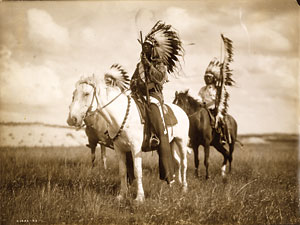Edward Curtis’ The North American Indian
Forever a marketer, Curtis wrote for Scribner’s magazine about the Indians and continued to lecture as well. He made a movie, In the Land of the Head Hunters, and developed a “picture-musicale.” He placed his photos in other writers’ books. He did most anything to showcase who he was and what he was doing. The first volume, published in 1907, focused on the Apache, Jicarillas, and the Navajo. Roosevelt wrote in the foreword, “In Mr. Curtis we have both an artist and a trained observer, whose pictures are pictures, not merely photographs; whose work has far more than mere accuracy, because it is truthful.”
His work continued. Volumes two and three were published in 1907. Volumes four and five came two years later. Volumes six, seven, and eight appeared in 1911. Volumes nine, ten, and eleven followed in 1913, 1915, and 1916, respectively. And then, on April 2, 1917, America entered World War I, and production of The North American Indian ground to a six-year halt.
The war, the sinking of the Lusitania, his financial failures on his musicales and movies, and his benefactor’s death—Morgan died in 1913—made it impossible for Curtis to continue his field work properly. Though Morgan’s son continued to finance the project, Curtis couldn’t find enough subscribers to continue in any meaningful way.
His wife filed for divorce in October 1916. Though not final until 1919, Curtis lost to his wife his studio and all his original camera negatives. Rather than have Clara take them from him, he and his daughter Beth destroyed them.
With his health failing, Curtis moved to Hollywood with his daughter in 1922. He opened a new photo studio. Desperate for money to continue documenting the Indians, he took still photos at movie studios. He took pictures of Tarzan. In 1923, though not credited, he was an assistant cameraman for Cecil B. DeMille’s epic silent film, The Ten Commandments.
With some money in hand, work commenced. Volume twelve came out in 1922, followed by thirteen and fourteen in 1924. Fifteen, sixteen, and seventeen were published in 1926, with volume eighteen coming two years later. Support, however, was virtually non-existent. The American public was no longer interested in Curtis’ ethnographic viewpoints. The whole project had dragged on too long; it was supposed to have been completed by 1912. It was 1930 when volume nineteen and the last volume (The American Eskimo) were finally completed. The New York Herald called it, “The most gigantic undertaking in the making of books since the King James edition of the Bible.”
Instead of feeling triumphant, Curtis was physically and mentally exhausted, and he had little to show for his long and arduous efforts. His family was fractured. His finances were drained. The public interest in Indians was gone. His benefactors and friends were dead. In 1935, the Morgan estate sold the rights and remaining unpublished materials to Charles Lauriat, a rare-book dealer in Boston. Lauriat acquired nineteen complete sets and fifty additional sets using remainder materials and photogravures printed on different paper. What the company couldn’t sell was put in storage. There it sat, forgotten, for about thirty years.
Lauriet’s stored materials were rediscovered in the 1970s, as interest in Curtis’ photography increased. Curtis, however, was long dead. He had suffered a fatal heart attack in 1952 and was buried at Forest Lawn Memorial Park in the Hollywood Hills. His simple marker reads, “Edward S. Curtis. Beloved Father.”
By the 1970s most all of Curtis’ sets were residing in libraries and museums—J. P. Morgan’s personal set rests comfortably at the Morgan Library and Museum in New York City. With many of the negatives destroyed, Curtis’ work became scarce and collectible. “It was,” said Makepeace, “the most comprehensive and most gorgeous documentation of Native American life that has ever been made.”
Now, people like Flury, Kapson, and Cardozo continue to showcase Curtis’ artistic genius and sell what remains of his works. They do it because they love his work, and so people like Raven Blanket won’t be forgotten. Nor Dusty Dress. Nor New Chest and Lone Flag, Bear’s Teeth and Red Star, Captain Charlie, and Crow Ghost. As Curtis said, “The passing of every old man or woman means the passing of some tradition, some knowledge of sacred rites possessed by no other; consequently the information that is to be gathered for the benefits of future generations, respecting the mode of life of one of the great races of mankind, must be collected at once or else the opportunity will be lost for all time.”








